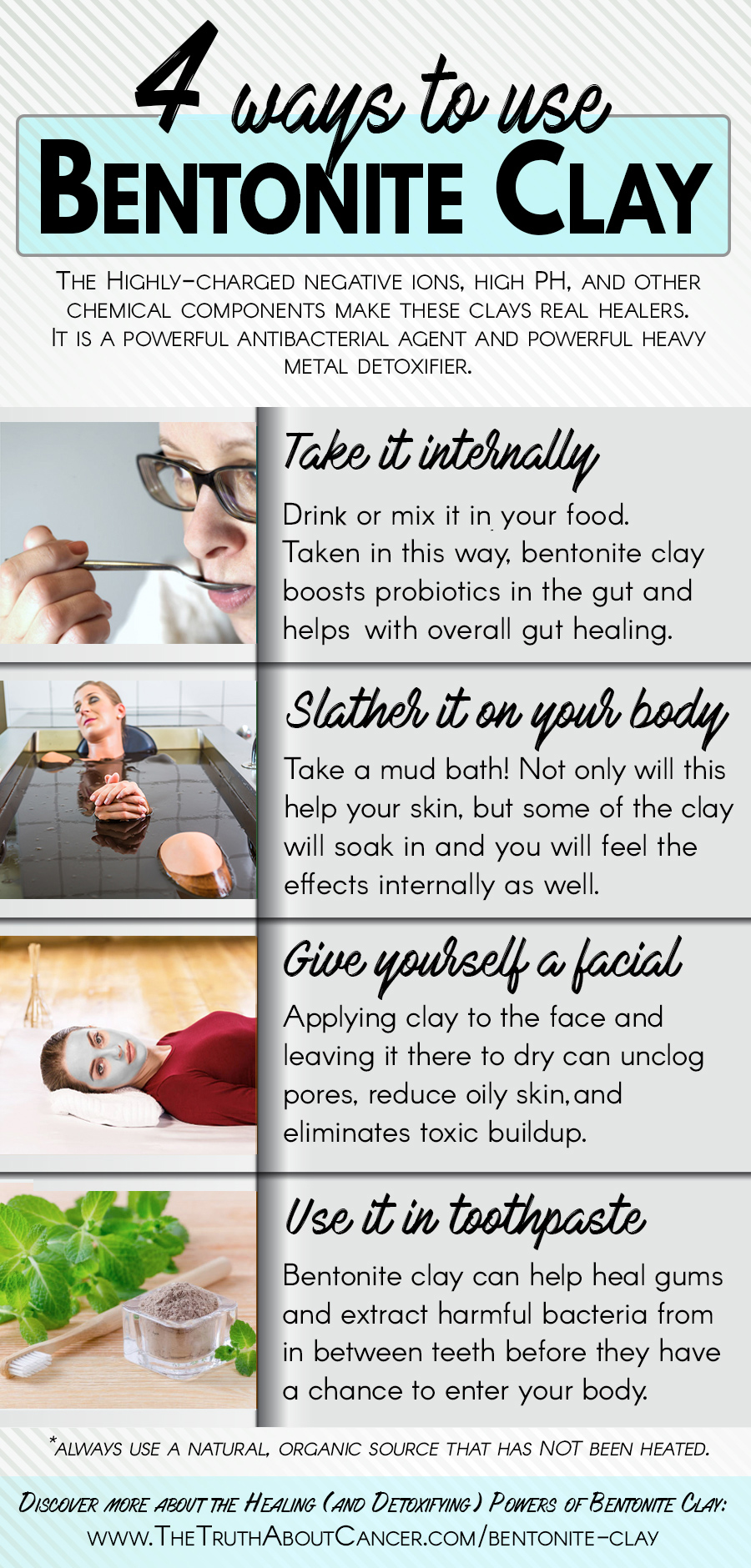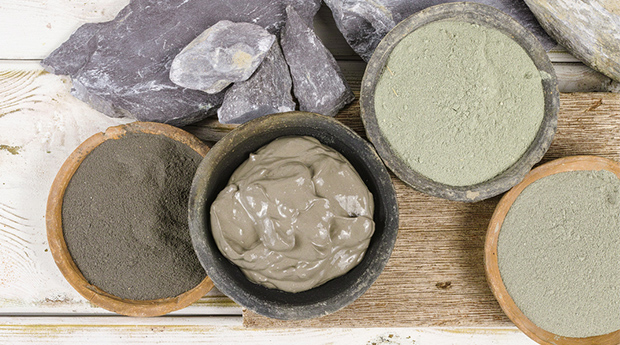I don’t know about you, but when I was a kid, I always had my hands in the mud. It just felt good to be connected to the earth in that way. As it turns out, there really is something to that spontaneous impulse most young children to “get dirty” when they play outside. Research over the last ten years has proven what us kids knew back then and what native peoples have known for centuries… the awesome anti-viral, anti-bacterial, heavy metal detoxifying effects of clay. And in particular, a type of clay I want to share about today − bentonite clay.
What is Bentonite Clay?
The term “bentonite” references the area where most of this kind of healing clay currently comes from: The Cretaceous Benton Shale in the southeastern area of Wyoming. Other geographical locations where bentonite-like clay occur are: Montmorillon, France (called “Montmorillonite” clay), as well as in Italy, Canada, Australia, and parts of Central and South America.
The way that these kinds of clays are formed is part of what makes them so healing. They are composites of volcano ash and are formed when volcanoes spew molten earth from the planet’s core. In fact, it is this “birthing process” out of extreme heat that creates the highly-charged particles and unique high-pH value that allows these clays to bind to toxins.
Bentonite Clay Gets Rid of Bacteria, Viruses, and Heavy Metals
Highly-charged negative ions, high pH, and other chemical components make these clays real healers on a few fronts.
First of all, clay is a powerful antibacterial agent. Being highly charged with negative ions, it will naturally bond with substances that have a high positive charge, such as viruses and bacteria. In the case of viruses such as E-Coli, Staphylococcus Aureus, MRSA, and others, clay molecules literally surround the viruses, suffocating them and preventing them from reproducing or getting fuel. Thus, the viruses die off and are carried out of the body through the body’s detoxification pathways.
A January 2017 clinical trial sponsored by the U.S. Centers for Disease Control and Prevention (CDC) used a calcium montmorillonite clay in the treatment of aflatoxin B1 for infected families in rural Kenya. Aflatoxin is a very potent form of fungus (i.e. mycotoxin). It is typically found in grains such as corn and cottonseed meal as well as in stored peanuts and can cause severe immune-suppression. The researchers in Kenya reported that the oral administration of this kind of clay was “effective, acceptable and palatable” for ridding the body of aflatoxin.
And just recently, researchers at the University of British Columbia (UBC) found that the naturally-occurring clay that the Heiltsuk First Nation people around the Kisameet Bay, BC area had been using for generations was more effective for curtailing certain bacterial infections than antibiotics. In particular, this form of bentonite clay was highly effective on “ESKAPE” pathogens, including “Enterococcus faecium, Staphylococcus aureus, Klebsiella pneumoniae, Acinetobacter baumannii, Pseudomonas aeruginosa, and Enterobacter.”
According to the UBC report published in the 2016 edition of American Society for Microbiology’s mBio journal, these particular forms of bacterial infections comprise the majority of U.S. hospital-borne infections. And, they are often not able to be remedied by antibiotic drugs.
Another way that clay can be beneficial is as a powerful heavy metal detoxifier. Clay has the ability to bond with heavy metals such as mercury, cadmium, and lead. These metals are found in everyday household products, in the air, and even in some processed foods such as high fructose corn syrup. In the same way that bentonite clay can expel bacterial pathogens from the body, it does the same for toxins such as these. In the process it also lowers inflammation and increases immunity. Bentonite also contains vital healing minerals within it, such as magnesium, calcium, iron, and potassium.
4 Ways to Benefit from the Healing Powers of Clay
The best thing about healing with clay is its diversity. Not only can it be ingested to get the internal effects mentioned above, it can be applied topically as well. By putting it on your skin you can utilize its ability to heal skin-borne infections and conditions such as eczema and benefit from it as a beauty agent as well!
Here are four ways that you can take advantage of the healing power of betonite clay:
- Take it internally. This means by either drinking it or mixing the powder in food. Bentonite clay taken in this way has been known to boost probiotics in the gut and help with overall gut healing. It has been used for IBS and constipation. As mentioned above, ingesting it internally also helps alleviate internal bacterial infections and purge heavy metals from the body.
- Slather it on your whole body. Take a mud bath! Although this way of application may be a little too messy to do at home, there are dozens of spas and healing centers nowadays that offer whole-body clay soaking for healing and detoxification. Not only will this help your skin, but some of the clay will soak in and you will feel the effects internally as well. Check to see if there is a naturally-sourced mud bath in your area − then dive in!
- Give yourself a facial. Why not take the time to enjoy the healing and calming effects of a clay facial? Applying clay to the face and leaving it there to dry can unclog pores, control the amount of natural oil (or sebum) the face produces, and eliminates toxic buildup. It can also exfoliate, gently minimize scars, and give your face a healthy “glow.”
- Use it in toothpaste. Bentonite clay can help heal gums and extract harmful bacteria from in between teeth before they have a chance to enter your body. Some commercial toothpastes contain clay or you can simply mix it in water, swish it orally for a minute, then spit it out.
Finally, in order to get the most out of your healing clay, always use a natural, organic source that has NOT been heated. Research has confirmed that heating clay to 900 C (approx 1650 F) or above destroys its structure and its capabilities to bond with bacteria, heavy metals, and other toxins. In addition, if you use clay for detoxification, be sure to help out your liver and other detoxification organs by giving them a boost as well so that they can effectively eliminate the toxins.

Article Summary
Research over the last 10 years has proven what native peoples have known for centuries − the awesome anti-viral, anti-bacterial, heavy metal detoxifying effects of clay.
The term “bentonite” references the area where most of this kind of healing clay currently comes from: The Cretaceous Benton Shale in the southeastern area of Wyoming.
Clay is a powerful antibacterial agent. Being highly charged with negative ions, it will naturally bond with substances that have a high positive charge, such as viruses and bacteria.
Another way that clay can be beneficial is as a powerful heavy metal detoxifier. Clay has the ability to bond with heavy metals such as mercury, cadmium, and lead.
Here are four ways that you can take advantage of the healing power of betonite clay:
- Take it internally
- Slather it on your whole body
- Give yourself a facial
- Use it in toothpaste
To get the most out of your healing clay, always use a natural, organic source that has NOT been heated.





















Is this ok to be used on children’s skin?
“In the case of viruses such as E-Coli, Staphylococcus Aureus, MRSA, and others, ” Those are bacteriae, not viruses.
What do you use to boost your liver and other organs while using the clay to detox .
Where in Canada can I buy some clay?
I’ve used bentonite clay from time to time and afterwards noticed worse symptons from aluminum, which it contains. It is a source of silica, but a tainted one.
Hi Ellen –
Thanks for sharing this with us.
It’s great that you’re paying attention to your body and the signs it’s giving you. We would firstly suggest getting the highest quality bentonite clay and to consult with your health practitioner about this. If you’re noticing more sensitivity, then it may not be right for you.
But most experts agree that the natural aluminum in bentonite clay cannot be absorbed by the body.
Hope this helps! Blessings and love from TTAC family to yours!
Will this effect my seizure medications if i eat it?
Hi Pat –
We appreciate you reaching out to us about this.
Please do consult with a healthcare professional regarding any medications you’re currently be taking.
Unfortunately, we are unable to give any kind of medical advice. The best advice we can give you is to consult with one of the doctors we interviewed in the Global series.
Please note that we are not able to select an expert for you.
We’ve created a page with the experts’ contact info as it was available to us.
Here’s the link to the actual webpage:
http://thetruthaboutcancer.com/experts-info-sheet/
We do have one more resource you may be interested in. During our Live Event 2017 series, Dr. Patrick Quillin suggested contacting The Institute of Functional Medicine to locate a practitioner in your area.
If you are interested, here is the link to search for a Functional Medicine Practitioner in your area: https://www.ifm.org/find-a-practitioner/
Blessings and love!
I wish they had explained the details on how to support your liver when using Bentonite clay!
Dandelion tea and milk thistle supplement
In regards to detoxification of heavy metals with BENTONITE, are there any other metals like ALUMINUM, BARIUM, STRONGIUM, SULPHER, etc.(mentioned in GEOENGINEERINGWATCH.ORG, Vaccines, etc.) that can be detoxed by Bentonite or another similar product? Hospitals don’t check for these.
“Another way that clay can be beneficial is as a powerful heavy metal detoxifier. Clay has the ability to bond with heavy metals such as mercury, cadmium, and lead” These are checked
Can you recommend a good brand of this that can be injested?
Two questions:
—Does bentonite clay absorb or deplete vitamins and minerals from the body?
—Is there a recommended length of time one should take bentonite clay?
Where can you purchase this type of clay in Ottawa, Canada? Can it be purchased at a local Health food store?
How much Bentonite to ingest at a time? Would someone from this website please answer all the questions? It does no good to people if we have questions that go unanswered> Thank you!